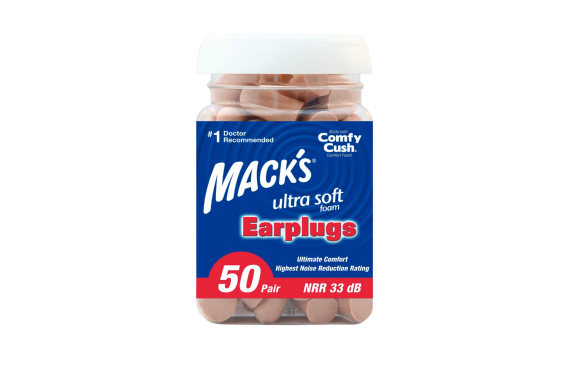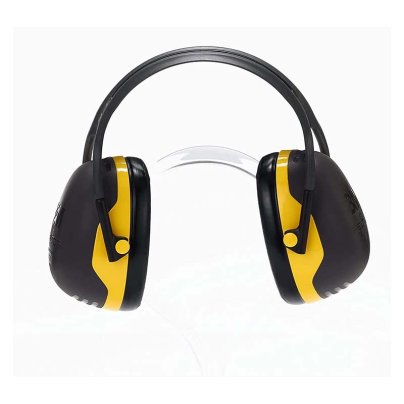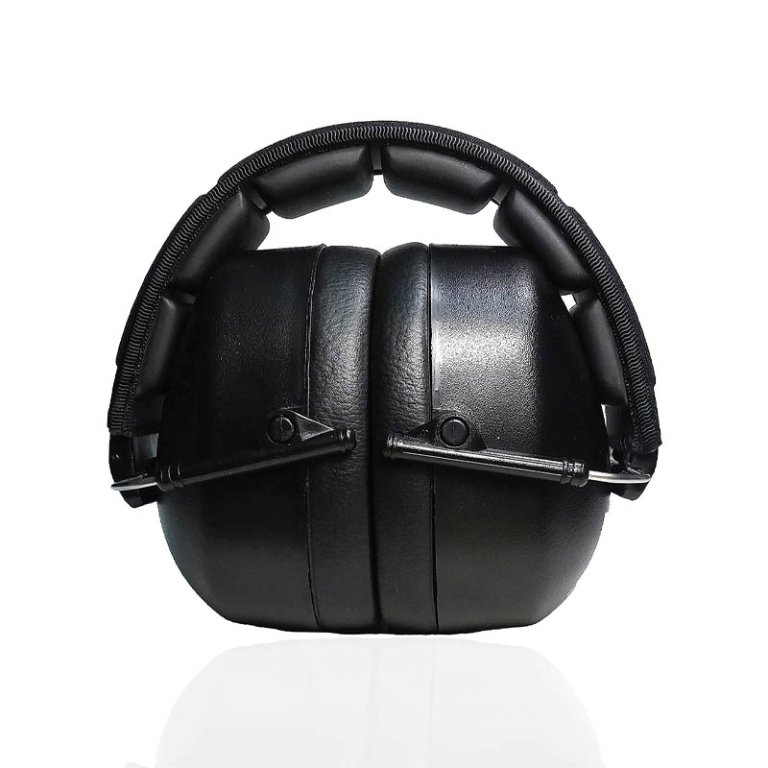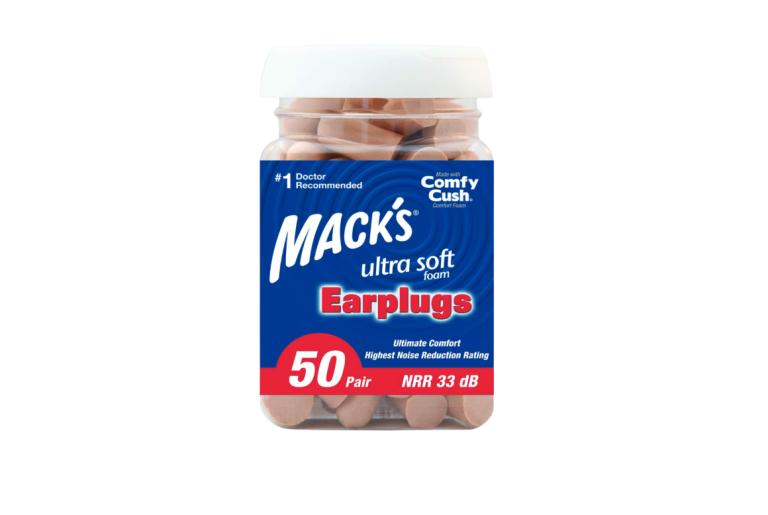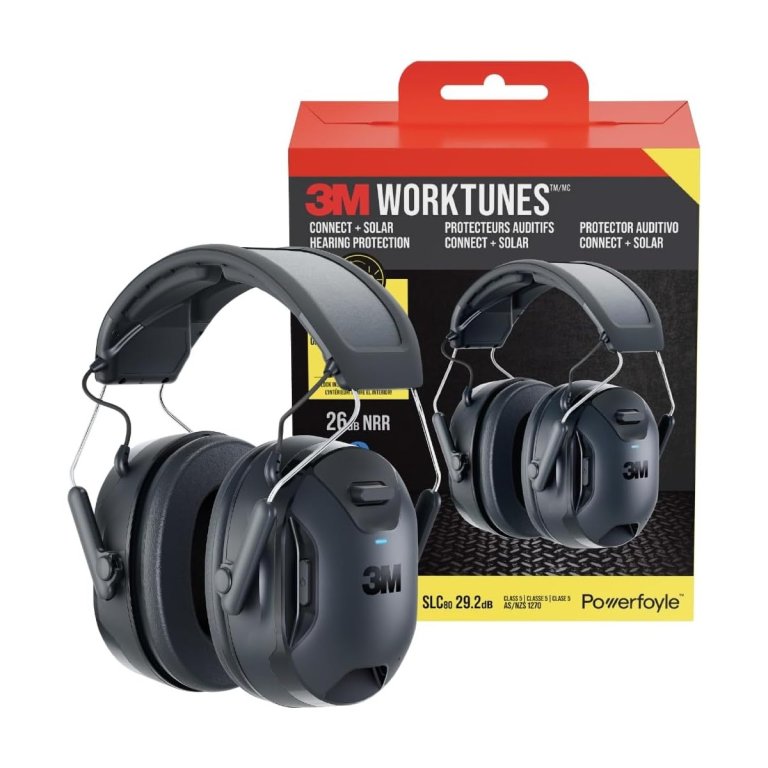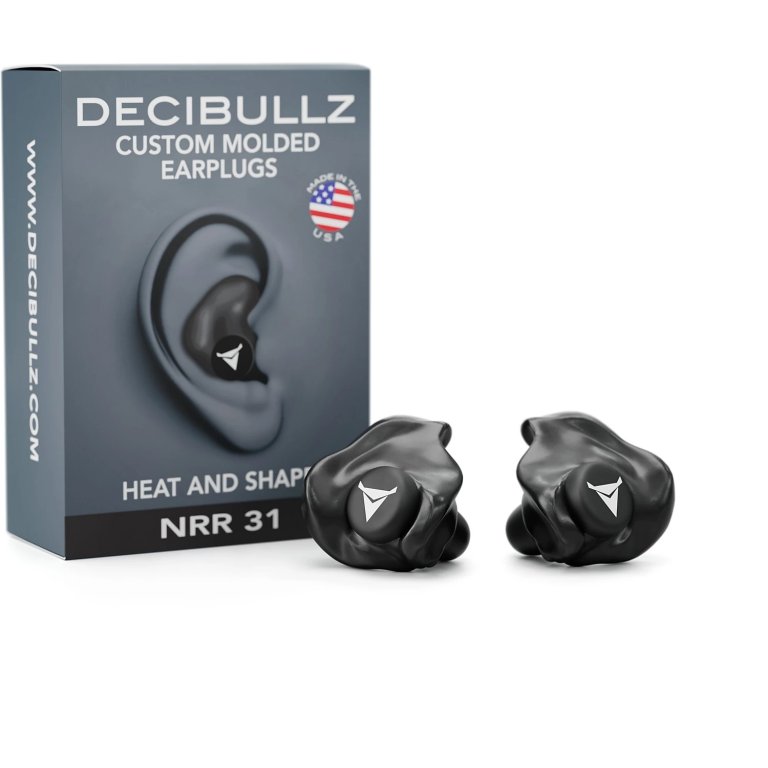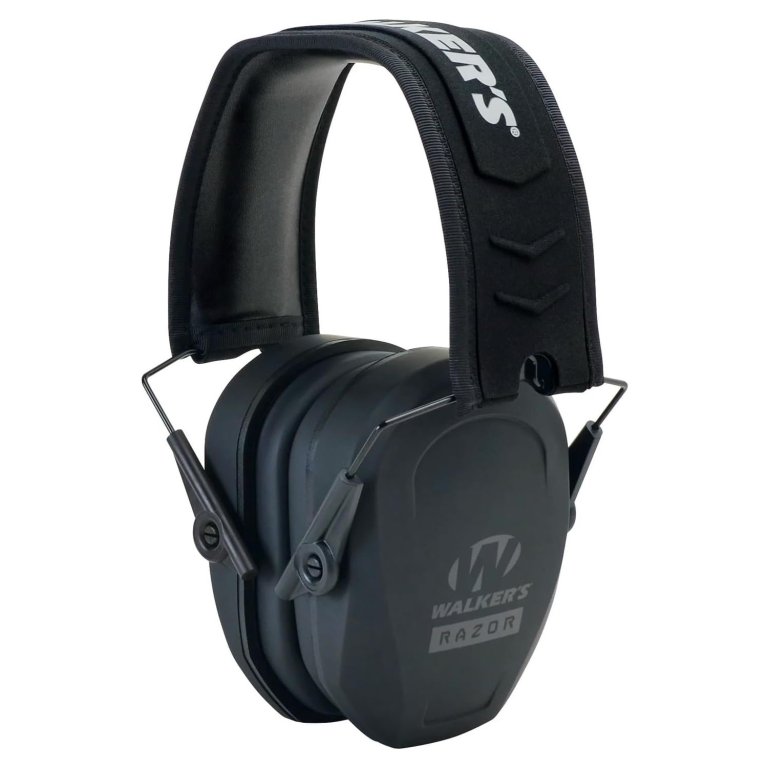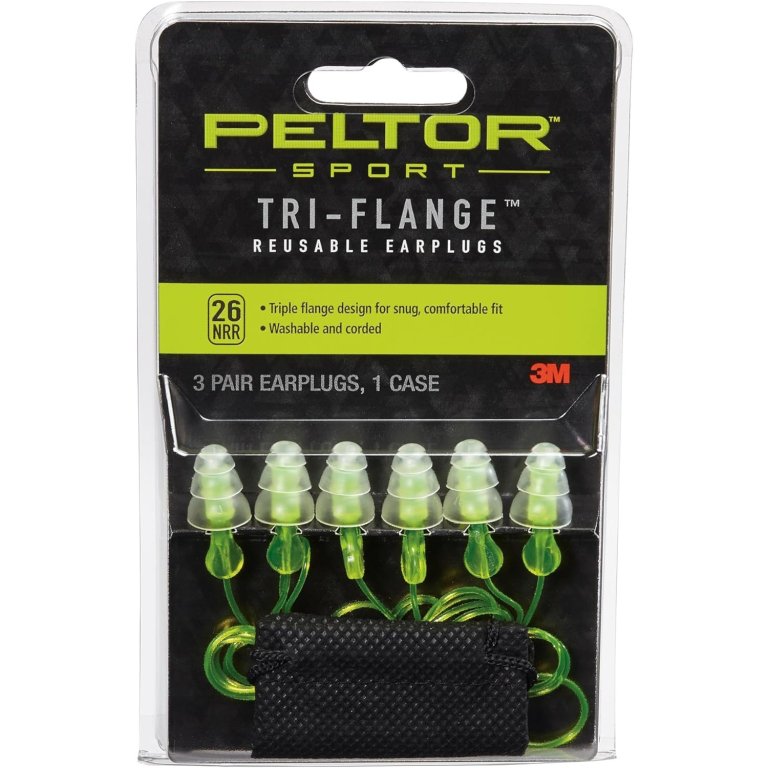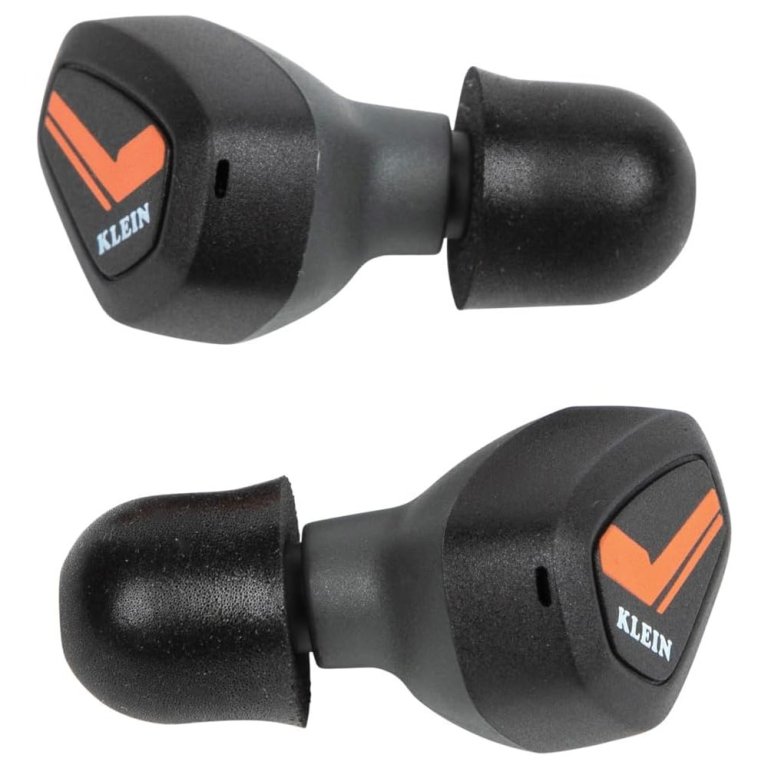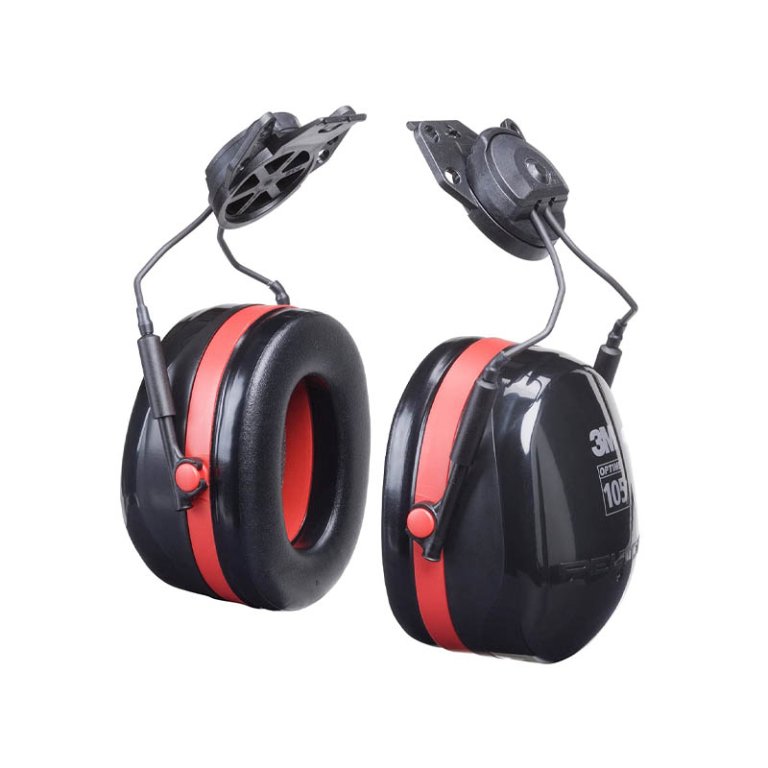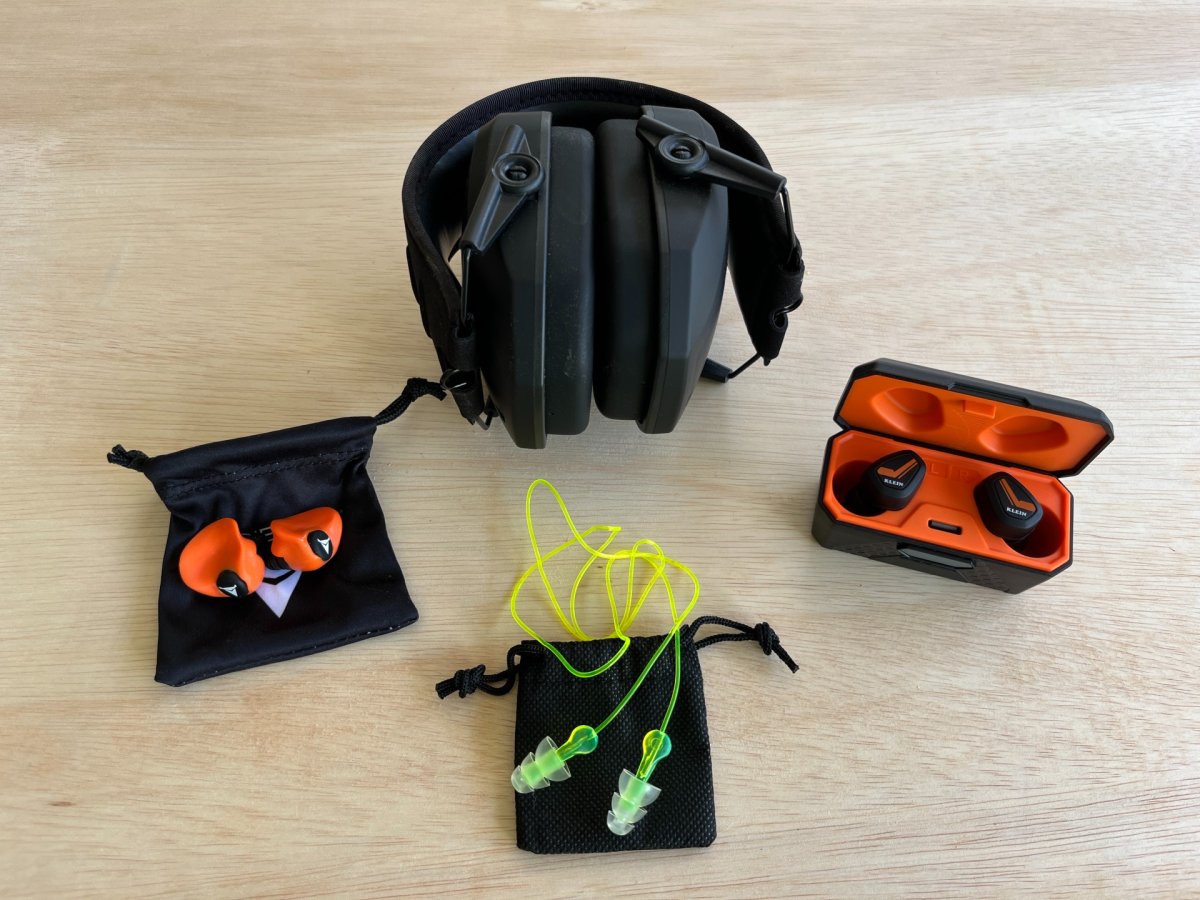
We may earn revenue from the products available on this page and participate in affiliate programs. Learn More ›
If you spend time operating power tools and noisy machinery, an investment in good hearing protection is money well spent. Loud noises cause hearing loss by damaging sensitive cells in the ears. You will find a diversity of hearing protectors that can block out damaging noise levels, including over-the-ear and in-the-ear types. We tested more than a dozen earplugs and earmuffs while operating different tools and machinery in order to find the most effective, affordable, and comfortable options.
Decibel Defense Safety Earmuffs took our top spot. They were comfortable to wear and blocked out more noise than most of the other products we tested. They were also one of the most affordable options of the group. But they were bulky, and the headband may not suit those who wear a hat while they work. Additionally, some users will prefer the added convenience of Bluetooth connectivity, which our top pick does not offer. Luckily, we included eight of our favorite hearing protectors in this guide to showcase a full range of alternatives. Read on for our expert take on choosing the best hearing protection products to prevent hearing loss.
- BEST OVERALL: Decibel Defense Safety Earmuff
↓ Jump to Review - BEST BANG FOR THE BUCK: Mack’s Ultra Soft Foam Earplugs
↓ Jump to Review - BEST BLUETOOTH: 3M WorkTunes Connect+ Solar
↓ Jump to Review - BEST CUSTOM MOLDED: Decibullz Custom Molded Earplugs
↓ Jump to Review - BEST LOW PROFILE: Walker’s Razor Slim Passive Earmuff
↓ Jump to Review - BEST EAR PLUGS: 3M Peltor Sport Tri-Flange Earplugs
↓ Jump to Review - BEST NOISE CANCELLING: Klein Tools Bluetooth Jobsite Earbuds
↓ Jump to Review - BEST FOR HARD HATS: 3M Peltor Optime 105 Dielectric Earmuffs
↓ Jump to Review
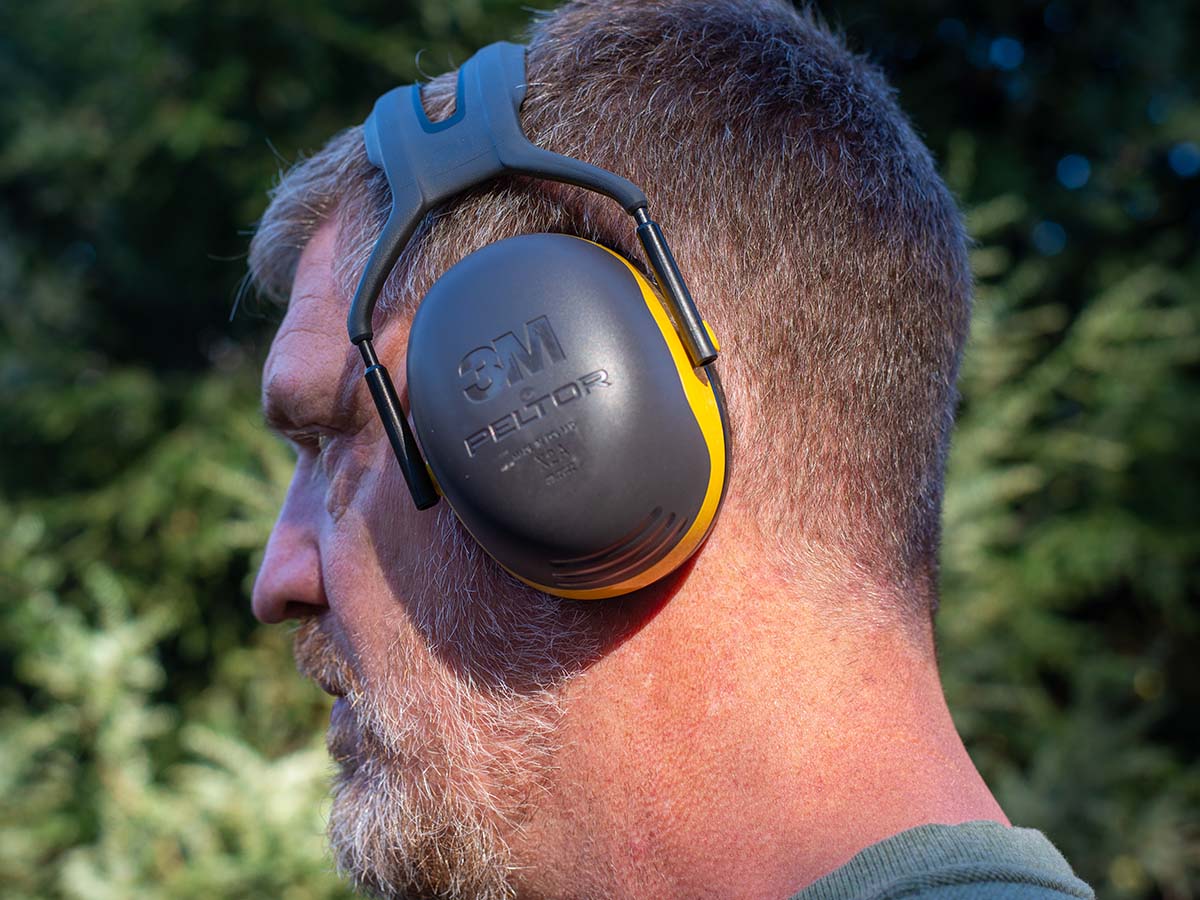
Hearing Protection Comparison Chart
| Product | Style | NRR | Extra Features |
| Decibel Defense Safety Earmuff | Over the ear | 37 | ANSI S3.19 certified |
| Mack’s Ultra Soft Foam Earplugs | In the ear | 33 | Bulk pack |
| 3M WorkTunes Connect+ Solar | Over the ear | 26 | Bluetooth connectivity, solar charging, water/sweat resistant |
| Decibullz Custom Molded Earplugs | In the ear | 31 | Custom fit, reusable, 6 colors to choose from |
| Walker’s Razor Slim Passive Earmuff | Over the ear | 27 | Slim profile, compact sizing |
| 3M Peltor Sport Tri-Flange Earplugs | In the ear | 26 | Reusable, high-visibility color, retainer cord |
| Klein Tools Bluetooth Jobsite Earbuds | In the ear | 28 | Bluetooth connection, noise isolation, changeable ear pads |
| 3M Peltor Optime 105 Dielectric Earmuffs | Over the ear | 27 | Hardhat mounts |

Our Top Picks
Keeping the practical considerations discussed above in mind, we shopped for the best protective earplugs, semi-insert earplugs, and earmuffs. Then we put them through their paces in a home workshop Since each of these products has been independently lab tested and awarded an NRR rating, our tests focused on functionality, comfort, and convenience. Read on to learn more about how our picks performed in our tests, and why we count them among the best hearing protection options available.
Best Overall
Photo: AmazonPros
- Higher NRR than other earmuffs; provide superior protection in loud environments
- Vented padding in the headband and muffs improves comfort while on the head and when hanging from the neck
- Quality materials and durable construction held up well in our tool box test
Cons
- Foam padding inside the ear cups needed to be realigned prior to use.
Product Specs
- Style: Over the ear
- NRR: 34 dB
- Extra features: Padded headband
Our Ratings
| Comfort | 5/5 | Effectiveness | 4.8/5 | Quality | 5/5 | Value | 4.8/5 |
Decibel Defense’s Safety Earmuffs are a worthy choice for anyone who needs maximum hearing protection yet doesn’t like sticking earplugs into their ears. While few earmuffs can offer more than 31 dBs of hearing protection, the Occupational Safety and Health Administration (OSHA) rates these over-the-ear earmuffs at 34 dB, while the American National Standards Institute (ANSI) certifies them at 37 dB, offering as much protection as many earplugs.
These ear protection muffs have thick foam padding for closing off the ear as well as a comfortable headband with six individual pads that offer ample airflow. The telescoping arms allow for easy adjustment of the ear cups as well.
During testing, we found the Decibel Defense earmuffs to be very comfortable and effective. They didn’t squeeze excessively, and the deep pads sealed well around the ear. While the NRR claims are excellent, what we liked most about this model was how comfortable they felt when worn over the ears as well as on the neck when not in active use. Also, the thick steel wires that attach the muffs to the headband felt sturdier than the other earmuffs, giving Decibel Defense a higher-quality feel. The only issue we had was the foam inside one muff arrived misaligned, so we had to remove and reinstall it.
What our tester says: “It’s hard to beat the Decibel Defense. The sound-blocking ability was second to none. They were super comfortable to wear, and they cost less than most of the other products we tested. These will be my new go-to hearing protection earmuffs.”—Mark Wolfe, Product Reviews tester and writer
Get the Decibel Defense hearing protection at Amazon or Decibel Defense.
Best Bang for the Buck
Photo: AmazonWhat We Like
- Inexpensive earplugs with 33 NRR
- Easy to achieve a good seal
- “Single use” but reusable a few times if kept clean
- Combine with earmuffs for even more noise protection
What We Don’t Like
- Slow expansion in cold weather
Specs
- Style: In the ear
- NRR: 33 dB
- Extra features: None
Our Ratings
| Comfort | 5/5 | Effectiveness | 4.5/5 | Quality | 4.5/5 | Value | 4.7/5 |
The 50 foam earplugs in this pack offer superior noise reduction, incomparable comfort, and great value. With an NRR of 33 dB, they’re very effective at blocking loud sounds, and they’re barely noticeable once inserted, so they’re ideal for the workshop as well as for wearing for sleep.
The soft foam rolls easily and expands inside the ear canal and can be reused several times before it starts breaking down. For anyone who doubles up their hearing protection with a set of over-the-ear earmuffs, Mack’s earplugs’ soft foam will ensure that their ears stay comfortable while providing remarkable NRR.
It was very cold on the day we tested these earplugs, and in such low temperatures, it took about a minute and a half for them to expand fully in the ear canal. But once they did, we found them to be the most comfortable form of hearing protection in the group. Plus, the pack of 50 makes them an economical choice. We reused our test pairs at least five times; while we didn’t notice any foam breakdown, we tossed them after that to avoid any hygiene problems associated with dirty earplugs. We also doubled them up with earmuffs and found them to be just as comfortable and effective that way.
Get the Mack’s hearing protection at Amazon, Walmart, or Safeway.
Best Bluetooth Ear Muff
Photo: AmazonWhat We Like
- Bluetooth connection to mobile device
- Built-in microphone with background noise reduction
- Constant charging via an integrated solar cell
What We Don’t Like
- More expensive than other Bluetooth options
- May not fit over a hat and glasses
Specs
- Style: Over the ear
- NRR: 26 dB
- Extra features: Bluetooth connectivity, solar cell, water/sweat resistant
Our Ratings
| Comfort | 4.8/5 | Effectiveness | 4.5/5 | Quality | 5/5 | Value | 4.8/5 |
For a reliable Bluetooth connection with over-ear hearing protection, we recommend 3M WorkTunes Connect + Solar Hearing Protector. These Bluetooth ear protection muffs offer a 26 dB NRR, which is suitable for mowing, and they also pair with a mobile device to stream media or make phone calls. An onboard solar cell constantly charges the battery in outdoor or indoor lighting, so you never need to worry about losing your connection.
The solar cell is a significant improvement over previous WorkTunes ear protection headphones. That addition raised the price, but it definitely adds value. We spent more time testing these than the other Bluetooth hearing protectors because we wanted to see if we could wear down the battery. Starting with a full charge, we streamed audio for 45 hours under normal indoor light and never had to resort to the backup wall charging system. If you mostly use them outdoors, the solar cell should be sufficient.
We appreciated the noise reduction for mowing and other outdoor chores, but like other headphones, these may interfere with hats and safety glasses. The audio quality was really good for both music and conversation, and the microphone did a great job of filtering out mower noise during phone calls. They worked well up to about 30 feet away from the mobile device before the Bluetooth connection became sketchy, which is typical of Bluetooth technology. As for comfort, the WorkTunes headphones totally outclassed Bluetooth earbuds.
Get the 3M WorkTunes hearing protection at Amazon, Ace Hardware, Blain’s Farm & Fleet, or Staples.
Best Custom-Molded
Photo: Academy Sports+OutdoorsWhat We Like
- Fast and easy to mold
- Remoldable if needed for a better fit
- Durable and easy to clean
- Good sound-blocking ability
What We Don’t Like
- Foam insert may not fit every ear
Specs
- Style: In the ear
- NRR: 31 dB
- Extra features: Custom moldable, reusable, 6 colors to choose from
Our Ratings
| Comfort | 4.8/5 | Effectiveness | 4.8/5 | Quality | 5/5 | Value | 4.7/5 |
For the best combination of high NRR, cleanability, reusability, and a comfortable fit, consider Decibullz Custom Molded Ear Plugs. Shaping these do-it-yourself earplugs only takes about 10 minutes, and they offer a respectable 31 decibel NRR to protect your hearing from pretty much every kind of tool and machinery noise. The kit includes three sizes of silicone ear pads, one set of foam ear pads, and a drawstring storage sack for the plugs.
Decibullz earplugs are not for those who are squeamish about putting objects in their ears. Molding them requires soaking them for 5 minutes in boiling water and then pressing them into the ear cavity. It worked perfectly the first time for us, although some users report difficulty shaping them. The plugs harden as they cool, but they can also be remolded if necessary.
As for noise-blocking ability, Decibullz were great. They were equal in performance to cheap squishy foam plugs but with the added benefit of being more permanent. We expect the plugs to last a long time, though, for the price, we would have appreciated a few more sets of foam ear pads.
Get the Decibullz hearing protection at Amazon, Tractor Supply Co., or Academy Sports+Outdoors.
Best Low-Profile
Walkers Razor Slim Passive Earmuff
Buy at Amazon Buy at Sportsman’s Warehouse Buy at Academy Sports+OutdoorsWhat We Like
- Slim fit is better for smaller heads
- Comfortable in use and in standby
- Good NRR for use in workshop and yard
- Fits over ball caps or under hoods
What We Don’t Like
- More inward pressure than some other headphones
Specs
- Style: Over the ear
- NRR: 27 dB
- Extra features: Compact sizing, slim profile
Our Ratings
| Comfort | 5/5 | Effectiveness | 4.5/5 | Quality | 5/5 | Value | 4.7/5 |
For those who prefer over-ear hearing protection to plugs, Walker’s Razor Slim hearing protection muffs are worth checking out. They are lightweight and designed for a better, more comfortable fit on smaller heads. The adjustable muffs feature slim ear cups and fold inward for compact storage. The 27 dB NRR provides adequate protection when using even the loudest power tools and outdoor equipment.
The lightweight, low-profile fit felt less cumbersome than even our top pick, including while wearing them around the neck on standby. They did a great job minimizing lawn mower and workshop noise, and they fit well over a low-profile ball cap or under a hood. However, they are not compatible with the broad-brimmed hats that some folks prefer for sun protection. The soft padding allowed us to use the muffs with safety glasses, but doing so let in some noise. They also fit well over foam earplugs when we wanted to add another layer of soundproofing.
Get the Walkers hearing protection at Amazon, Sportsman’s Warehouse, or Academy Sports+Outdoors.
Best Earplugs
Photo: AmazonWhat We Like
- Lightweight and comfortable to wear
- High visibility plastic retainer cord helps prevent loss
- Easy-to-clean silicone ear plugs
- Compatible with hats and safety glasses
What We Don’t Like
- Do not seal as easily as foam plugs
Specs
- Style: In the ear
- NRR: 26 dB
- Extra features: Reusable, high-visibility color, retainer cord
Our Ratings
| Comfort | 4.8/5 | Effectiveness | 4.5/5 | Quality | 4.5/5 | Value | 5/5 |
These 3M Peltor Tri-Flange Earplugs are the best of their kind because they are affordable, reusable, and effective. The flanged plugs fit different ear canal shapes and sizes, but they do not require rolling like foam earplugs. Instead, these silicone plugs feature rigid stem grips that make them easy to insert. They are washable and reusable. The ones we tested came with vinyl retaining cords, but Peltor Tri-Flang earplugs are also available with cloth cords.
We prefer in-the-ear hearing protection like earplugs over earmuffs for outdoor work because they are not as hot in summertime and because they are easier to use while wearing a hat and safety glasses. In this case, the vinyl retaining cords were well attached to the plugs, so we didn’t have to worry about them breaking, but they tended to feel sticky on the back of the neck. The NRR rating on these plugs was lower than some of the others we tested, but they are adequate for mowing by bringing the noise level down from 100 dB unfiltered to less than 75 dB entering the ear.
What our tester says: “Reusable plugs make more sense than pretty much any other type of hearing protection for working outside in hot weather. I especially like these 3M silicone plugs because they hold up longer than the foam kind and they are much easier to keep clean.”—Mark Wolfe, Product Reviews tester and writer
Get the 3M Peltor hearing protection at Amazon, Walmart, or All Industrial Tool Supply.
Best Noise-Cancelling
Photo: AmazonWhat We Like
- 5 hours of runtime (15 with case)
- IP65 rated against dust and water damage
- Built-in microphone
- Lightweight, low-profile design
What We Don’t Like
- Cannot run for a full day per charge
Specs
- Style: In the ear
- NRR: 28 dB
- Extra features: Bluetooth connectivity, noise isolation, changeable earpads
Our Ratings
| Comfort | 4.8/5 | Effectiveness | 4.8/5 | Quality | 5/5 | Value | 5/5 |
Hearing protection with Bluetooth allows you to stay safe and connected while working in the shop or cutting the grass. The Klein Tools Bluetooth hearing protection earbuds are purpose-built for loud work environments, with noise isolation technology and 28 dB of noise reduction. They are also IP65-rated to prevent damage from dust and water intrusion.
With up to 5 hours of runtime per charge—15 hours with the included charging case—these earbuds can stream music and answer phone calls throughout the day. They were easy to set up and adjust, and they did a great job blocking out machine noise. They delivered really good music and voice sound quality, too. The built-in microphone produced perfect clarity for listeners on the other end of phone calls, even while we worked.
Perhaps best of all, these earbuds were much smaller and lighter in weight than others we’ve tried, although they didn’t run as long per charge as some. Given the choice, we decided that comfort was more important than a bigger, heavier battery.
Get the Klein Tools hearing protection at Amazon, The Home Depot, JB Tools, or ToolUp.
Best for Hard Hats
Photo: AmazonWhat We Like
- Easy pivot from use to standby
- Secure hard hat anchor points
- Deep-padded ear cups
What We Don’t Like
- Not compatible with wide-brim hard hats
Specs
- Style: Over the ear
- NRR: 27 dB
- Extra features: Hard-hat clips
Our Ratings
| Comfort | 5/5 | Effectiveness | 4.5/5 | Quality | 4.5/5 | Value | 4.7/5 |
Due to the bulky headband, traditional earmuffs won’t work when wearing a hard hat—but 3M’s Peltor Optime earmuffs represent a solution. This set of earmuffs snaps into the rim of most hard hats, offering protection that works with other personal protection equipment (PPE).
These earmuffs offer protection from dangers on construction sites or while felling trees. They can be easily swiveled down to protect the ears, then swiveled back up and out of the way when not in use. With an NRR of 27 dB, they’re some of the most effective earmuffs on the market.
During testing, it was easy to see the value that these 3M Peltor Optime earmuffs offer. We liked that they swiveled up and down, allowing us to keep a hard hat on while choosing whether or not to wear the muffs. They attach securely, with no chance of them coming loose or falling off. And while we couldn’t necessarily tell the difference between these earmuffs and others with lower ratings, we appreciated their higher NRR value. Our one complaint is that they are not compatible with every hard hat style, such as our wide-brim hard hat.
Get the 3M Peltor Optime hearing protection at Amazon, Walmart, or Staples.
Jump to Our Top Picks
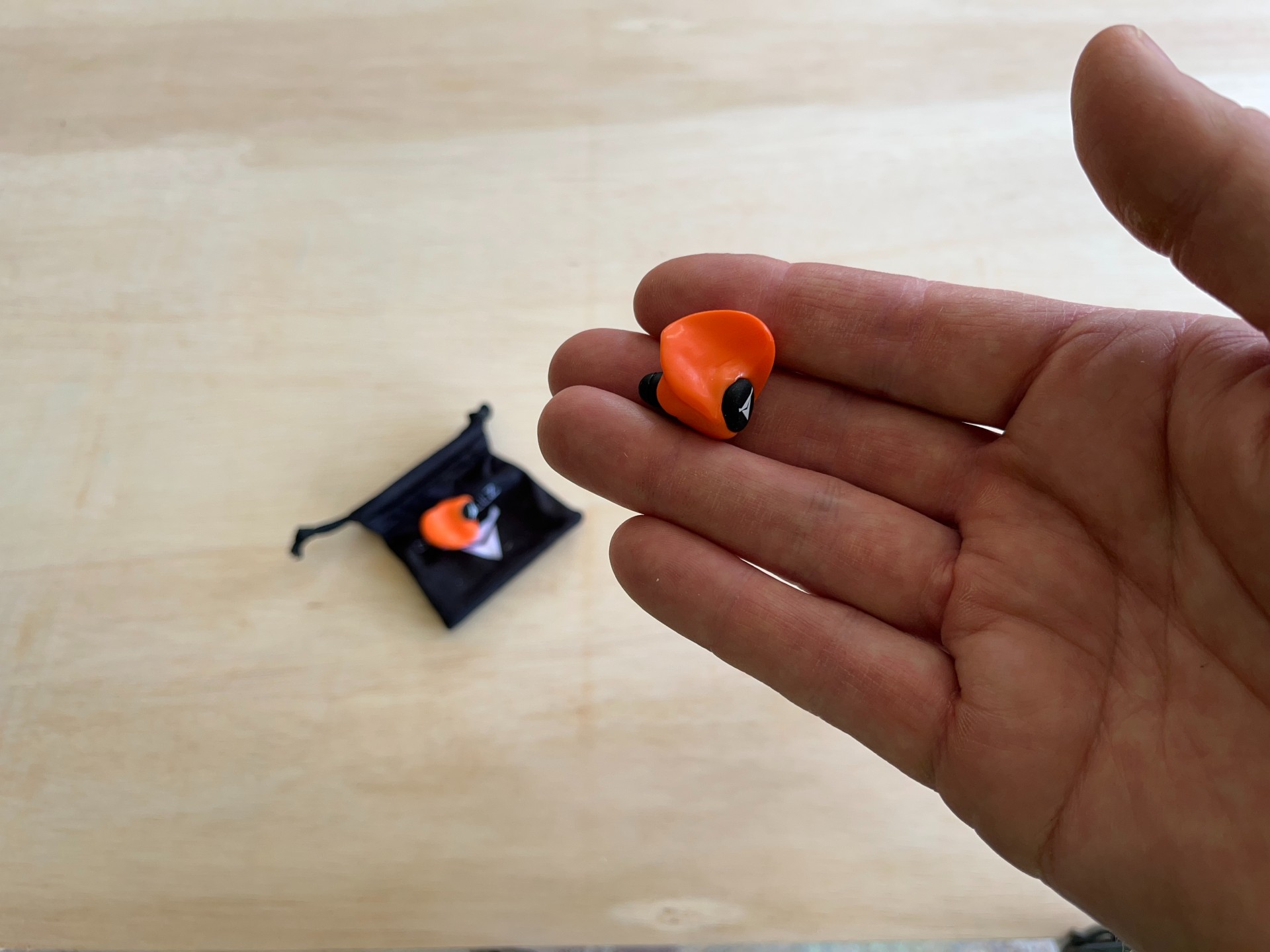
How We Tested the Best Hearing Protection Options
| Products tested | 13 |
| Time spent testing | 5 days |
| Tests performed | 6 |
| Price range | $10 to $145 |
We spent 16 hours researching hearing protection, OSHA hearing protection standards, and ANSI NRR ratings. Then we compiled a list of products for testing. Every device on our list had been independently lab tested and certified with an NRR value, so we focused on two rounds of hearing tests in order to explore convenience, comfort, and perceived noise-level reduction as well as durability.
First, we donned each set of earmuffs or earplugs in a workshop while working with a table saw, miter saw, and router. Then we moved outdoors and retested while operating a gas-powered riding mower, string trimmer, and backpack leaf blower. Finally, we tested each device for durability by dropping them off a workbench onto a concrete floor multiple times and carrying them around in a tool bag for a week. After testing each product, we rated them on a scoring rubric to identify an overall pick and the various category winners.
| Product | Comfort | Effectiveness | Quality | Value |
| Decibel Defense Safety Earmuff | 5/5 | 4.8/5 | 5/5 | 4.8/5 |
| Mack’s Ultra Soft Foam Earplugs | 4.5/5 | 4.5/5 | 4.5/5 | 4.7/5 |
| 3M WorkTunes Connect+ Solar | 4.8/5 | 4.5/5 | 5/5 | 4.8/5 |
| Decibullz Custom Molded Ear Plugs | 4.8/5 | 4.8/5 | 5/5 | 4.7/5 |
| Walker’s Razor Slim Passive Earmuff | 5/5 | 4.5/5 | 5/5 | 4.7/5 |
| 3M Peltor Sport Tri-Flange Ear Plugs | 4.8/5 | 4.5/5 | 4.5/5 | 5/5 |
| Klein Tools Bluetooth Jobsite Ear Buds | 4.8/5 | 4.8/5 | 5/5 | 5/5 |
| 3M Peltor Optime 105 Dielectric Earmuffs | 4.8/5 | 4.5/5 | 5/5 | 4.3/5 |
What to Consider When Buying Hearing Protection
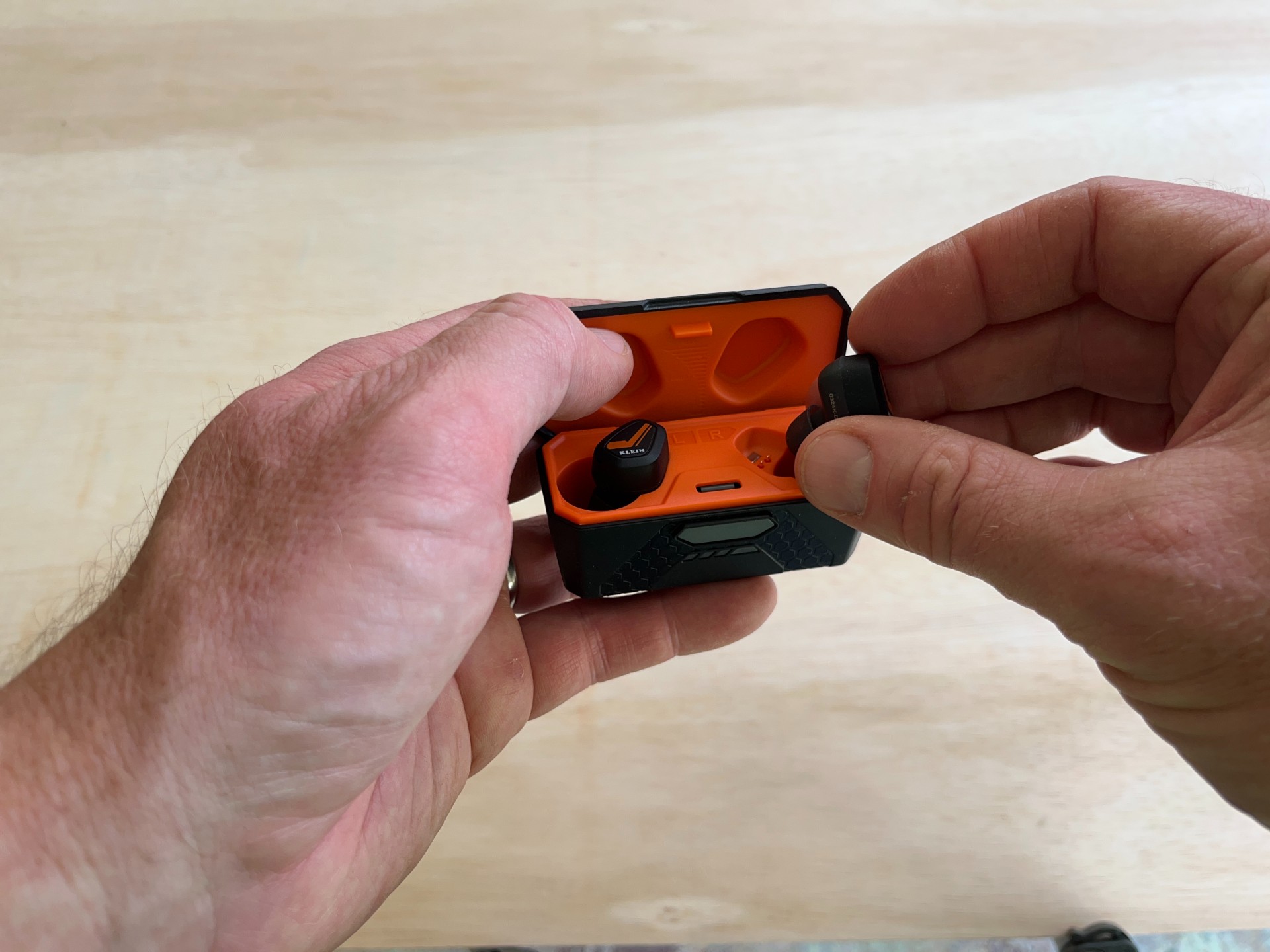
It’s great to have a host of options when deciding on the best hearing protection for personal needs. When searching for earplugs or muffs, the following factors and features will help shoppers find the ideal hearing protection for their workshop.
Types of Hearing Protection
When it comes to protecting workers’ hearing, there’s a variety of products on the market in different styles. Some of these options are more comfortable than others, while some have features, like reusability, that might appeal to eco-conscious consumers. The following are some of the most common types of hearing protection.
Earplugs
In garages and on construction sites, earplugs often appear as brightly colored dots tucked into the ears of workers and DIYers. These hearing protection products block the noise by closing off the ear canal completely, significantly reducing the decibel levels experienced by the ears.
Plugs are usually made of soft foam, which is rolled between the fingers to compress. Once placed in the ears, they expand and take the shape of the ear canal to prevent excessive noise from entering. These foam plugs can be reused several times, though eventually they may get dirty or begin to break down from repeated compressing and should be discarded. Silicone earplugs, often resembling little pine trees in shape, are also available. These rubber plugs are far more reusable but may not offer the same level of protection as foam plugs.
Canal Caps
Users who would rather not stick objects into the ear canals may prefer semi-insert earplugs, also known as canal caps. Instead of being rolled and compressed to fit inside of ears, canal caps use rigid headbands with rubber or foam plugs on the end. The headband creates just enough pressure to clamp the plugs in place over the ears, significantly reducing exposure to loud noises without needing to insert a plug deep inside the ear canal.
Canal-cap plugs are generally cone-shaped or rounded, ensuring a proper seal around the entrance of the ear. They can be reused over and over again. They’re great for home workshops, as it’s easy to take them out of the ears and wear them around the neck while performing quieter tasks and then quickly put them on when firing up a power tool.
Over-the-Ear
Over-the-ear hearing protection works without putting anything at all inside the ears. Muff-style hearing protection uses rigid headbands to hold hard shells with soft foam pads over ears. They keep abrasive noises from entering by creating a seal around the entire ear.
Earmuffs do an excellent job of protecting hearing, but the foam can trap heat and the shells can be a bit heavy. They’re indefinitely reusable unless the padding rips or deteriorates. They work well in a shop, but because they can be a little cumbersome, they are less likely to be kept around the neck when not in use. This means needing to locate and put them on when it’s time to make noise, which isn’t always convenient.
Comfort
If hearing protection isn’t comfortable, it will be more difficult to wear—and therefore may be less likely to be worn. Therefore, it’s essential to choose plugs or muffs that are comfortable in the ears and, if applicable, around the neck.
Many people find earplugs to be the most comfortable form of ear protection. They’re light, soft, and usually comfortable enough to wear in warm conditions. Some come with a thin strap so they can be conveniently hung around the neck when not in use.
Canal-cap earplugs are also a painless option. The headbands should provide enough pressure to keep the plugs in the ears without creating discomfort. They’re also light and easy to wear around the neck when not in the ears.
Over-the-ear-style hearing protection can be a bit clumsy, particularly when worn in combination with safety glasses, but for those with particularly sensitive ears, they may be the only style that feels comfortable. It’s critical to find a pair that fits well but doesn’t create discomfort or cause the wearer to overheat when worn around the neck.
Noise Reduction
A Noise Reduction Rating (NRR) describes how many decibels a particular product lowers noise. For instance, a product with a 30 NRR will reduce a 100-decibel (dB) noise level to 70 dB.
Earplugs tend to have the best NRR. Some offer reductions as much as 33 dB. The most generally achieved from a set of over-the-ear earmuffs is 31 dB. If both of these styles are combined, an NRR of 36 dB can be maintained.
Figuring out what level of NRR is needed depends on the work that’s being done. Circular saws run somewhere in the range of 90 dB. To lower this to the accepted safe level of 70 dB and below, hearing protection with a 20 NRR or more will be needed. Here are some popular shop tools and lawn equipment along with the typical decibels they produce:
- Circular saws: 90 dB
- Miter saw: 102 dB
- Router: 95 dB
- Table saw: 92 dB
- Air compressor: 40 dB to 90 dB
- Gas chainsaw: 110 dB
- Gas lawn mower: 86 dB to 96 dB
- Gas string trimmer: 98 dB to 106 dB
- Gas leaf blower: 95 dB
PPE Compatibility
Personal protective equipment (PPE) is incredibly important for many reasons, but these pieces aren’t always compatible with every type of hearing protection. Folks who wear a respirator or goggles while working should ensure that their ear protection will not interfere with their PPE.
Earplugs are fairly universal, working with most forms of PPE. Semi-insert plugs are slightly more of a challenge, as the headband could tangle with a respirator’s straps or safety glasses.
Over-the-ear earmuffs are the biggest challenge. They may not work with a respirator, mostly due to the neck straps and the harness. Also, safety glasses that need to tuck underneath the muffs will create space for noise to sneak through, reducing the effective NRR rating of the muffs.
Temperature and Humidity
When it comes to hearing protection, temperature and humidity will have more of an effect on comfort levels than on effectiveness. Due to the nature of hearing protection products, they tend to lack breathability and can trap body heat. This isn’t as much of an issue with earplugs or semi-insert plugs, but it’s a major concern with over-the-ear earmuffs.
Over-the-ear muffs trap lots of body heat, both in the shell and the headband (especially when worn around the neck). The thick foam and airtight coating make it difficult for air to circulate, which can be particularly uncomfortable in non-air-conditioned spaces like workshops or garages. Consider using earplugs to stay cool and comfortable in these types of spaces.
Communication and Audibility
While the primary goal of hearing protection is to block out distracting noise, situational awareness is equally essential to staying safe in a work environment. If working with other folks nearby, being able to hear and understand them can help increase workflow and keep everyone safe.
If this is important, look into electronic hearing protection that detects and blocks dangerous decibel levels while still allowing the user to hear normal conversation and safe noises. These electronic plugs with active hearing protection cost more than standard options, but they make a huge difference when working around other people.
Bluetooth
Listening to music can improve workflows and help some people to better focus on the task at hand. But it can be challenging to hear a stereo while wearing hearing protectors, which is where a Bluetooth-enabled set of earplugs or muffs may come in.
With Bluetooth hearing protection, users can tune into a favorite music app while still protecting their hearing from excessive noise levels. There is also noise-canceling ear protection available with Bluetooth. Still, many of the same considerations apply to these devices as do standard hearing protection, including ensuring the plugs or muffs are compatible with PPE.
Additional Features
There are a few other things shoppers might want to look for when searching for the best hearing protection. When it comes to earplugs, some may prefer those that hang from a soft neck cord. They might also consider the material construction of the hearing protection. They may choose from inexpensive, compressible foam earplugs or longer-lasting silicone, rubber, or plastic types. For the best combination of ear fit, sound quality, and long working life, some shoppers choose to pay a premium for custom-molded earplugs.
Concerning earmuffs, it may be worth considering a lightweight option that won’t hang uncomfortably from the neck. In hot weather, sweat-wicking ear pads improve user comfort. Low-profile earmuffs also offer improved comfort, while deeper models may promise greater noise protection. Some boast electronic noise-canceling features to protect against impulse sounds that are common on construction sites or shooting ranges. For work environments requiring hard hats, choose earmuffs that attach to the headgear.
The Advantages of Owning the Best Hearing Protection

It’s all too easy to damage your hearing. In fact, a single exposure to a loud noise can cause permanent damage. Imagine what long-term repeated exposure to noisy or dangerous power tools can do. Owning and using the best hearing protection helps prevent hearing loss due to immediate and accumulated noise exposure.
Hearing protection that’s comfortable for one person may not feel so great on someone else. Shoppers who take the time to purchase the best hearing protection for their personal needs will ensure that they get the most use out of their plugs or muffs. After all, they won’t do any good sitting on a workbench.
If an employer requires hearing protection, it may be worth investing in personal earplugs or muffs rather than relying on company-provided ones. Employers may offer inexpensive PPE to meet particular insurance or OSHA requirements, which may be inferior to a high-end product. By purchasing their own high-quality hearing protection, workers can ensure maximum safety and comfort on the jobsite.
- Protects hearing from years of damage.
- Allows for personalization based on user needs.
- Ensures safety and comfort at home or on jobsite.
FAQs
A lot is riding on your choice of the best hearing protection, so if you still want more information, consider the answers to these common questions about these products. in your ears.
One of the best hearing protection products in terms of NRR is earplugs. They provide up to 33 dB of noise reduction. If you double them with an over-the-ear earmuff with an NRR of 31, you can obtain a combination NRR of 36 dB.
Anything less than 70 dB is widely accepted as safe. Above 70 dB, you should consider wearing hearing protection to lower your chances of damaging your hearing.
In-ear hearing protection does a better job of reducing noise, but over-the-ear protection is better than nothing. It’s largely dependent on what you’re comfortable with and how you plan to use it. It doesn’t matter if in-ear plugs are better if you’re too uncomfortable to keep them in your ears.
Single-use foam earplugs generally block out more noise, with an NRR between 28 and 33 dB. Reusable silicone earplugs are best for moderate noise levels, with an NRR range of 22 to 25 dB.
Consider wearing hearing protection if you work in a loud environment that causes you to raise your voice to be heard, if your ears feel uncomfortable, or if your ears ring during or after work. OSHA requires employers to offer hearing protectors at no cost to employees if they will be exposed to 8 hours of 85 decibels or higher.
With regular use and care, earmuffs last about 6 months. Replace them if the foam becomes stiff, cracked, or no longer seals around the ears.
Meet the Tester
Mark Wolfe is a writer and product tester who spent 20 years in the nursery and landscaping industry. For more than twenty years he mowed, edged, planted, pruned, cultivated, irrigated, and renovated beautiful landscapes. Now he tests and writes reviews about the latest outdoor power equipment, hand tools, lawn care products, and other outdoor living goods.
Additional research provided by Tom Scalisi.

